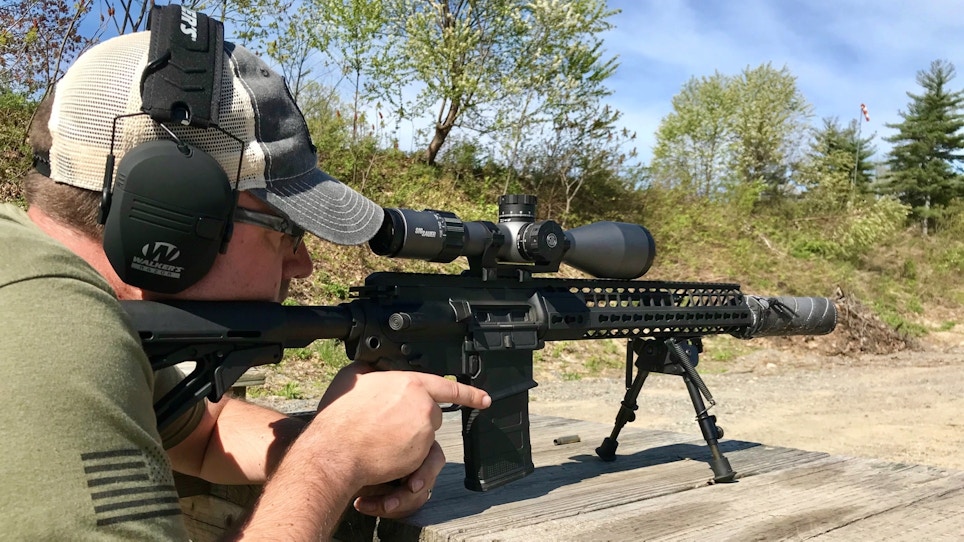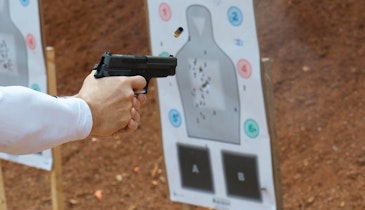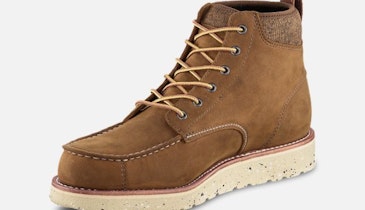
Long-range precision shooting continues to attract new shooters, which means potential customers for you. Whether the shooter's idea of long-range is 500 yards or 1,000 yards or more, they're passionate and laser-detailed about what they use. (Photo: Alan Clemons)
I’m often asked to predict the “next big thing” in firearms. First off, I have to consider trends. While handguns take the perennial first place award for sales, the AR-15 market has been very brisk, for well over a decade. But for the past two years, those sales have been in a slump. Waves of panic buys, fueled by threats of firearms restrictions have resulted in a glut for AR-style firearms. Something new is bound to come along and I think that next thing is Tactical Precision Shooting.
The AR-style rifle has been in use by military and police for over 50 years, making it a natural for the American gun owner. Although I served for more than 20 years split between the Army and Air Force, I was never assigned a bolt-action weapon. In fact, very few military personnel are snipers. Until my retirement, my experience was limited to hunting deer or the occasional opportunity to touch off a few rounds at various range days.
The vast majority of my experience with bolt-action rifles came after I re-entered civilian life, which is pretty common. I admit that my inexperience left me intimidated by their use. But then about three years ago, something happened which forever changed my attitude.
I participated in a Precision Rifle Series ProAm competition where I was paired with Retired Army Sniper Tom Fuller. I showed up on the morning of the first day and he showed me the rifle I’d be shooting. It was a GA Precision rifle worth thousands of dollars and chambered in 6.5 Creedmoor, a caliber I was unfamiliar with. The gun was more than capable of winning a match.
Fuller said, “Let’s get a couple of shots off so you can familiarize with the rifle. I sighted it in yesterday, so the zero should be good. Take a look way out to the right.” Pointing downrange, he said, “there’s a target at 800 meters.” My limited experience had been with .308 and its military cousin 7.62 NATO. I knew how wind and my lack of confidence could result in missed shots, and replied, “You think we could start at like 300 or 400 and work our way out?”
Fuller chuckled and said, “You’ll be all right,” as he relayed my hold for 800. “Bang!” came the report as I squeezed off my first round, hearing Fuller exclaim “Hit!” just before hearing the gong-like sound of my bullet impacting steel. Talk about a confidence builder! Fuller explained that the 6.5 Creedmoor cartridge features a fast projectile with a fairly flat trajectory. It made a believer out of me.
That experience certainly changed my mind about this type of shooting, but even then, I was shooting an expensive hand-built rifle, firing a specialized cartridge that had not yet gone mainstream, on a course of fire few had access to. From where I was looking, tactical precision shooting was going to remain a niche pursuit, but several factors have come together over the past few years to make all of that change.
First and foremost is the availability of complete rifles for the entry-level shooter. Traditionally, bolt guns were available off-the-shelf as hunting models or configured as sniper rifles for police and military. Alternatively, shooting competitions were being won with hand-built rifles costing thousands of dollars and requiring long lead times. All of that changed when the Ruger Precision Rifle (RPR) was introduced. At a third of the cost of many options, the RPR could get a shooter into a match, right out of the box.
Next, the rise in popularity of the Precision Rifle Series (PRS) of competitive shooting events has garnered increased participation as well as industry sponsorship. PRS takes the bench shooting discipline of extreme accuracy and adds the challenge of multiple targets at various ranges and the stress of a time limit and unconventional shooting positions. It’s a lot of fun, but not everyone can compete at that level or travel across the country every other weekend. Consequently, PRS has spawned locally-run matches all across the country that replicate the challenging courses of fire found at sanctioned PRS competitions. As more and more matches are organized, the sport continues growing in popularity.
Another major factor is the rise in popularity of the 6.5 Creedmoor caliber. Not only is it now outselling .308 match ammunition — it’s also less expensive. Last year, 6.5 CM was also adopted by the United States Special Operations Command for use in sniper support weapons and possible integration into their belt-fed machine guns. That was as much a result of the cartridge’s capability as it’s growing popularity among long range competitors, many of whom serve in our nation’s elite.
Hand in hand with the ammunition are magazines. The preferred bolt gun external magazine has been the Accuracy International model. Unfortunately, they have been very expensive. But over the past couple of years, several companies such as Magpul have copied the pattern and introduced less expensive alternatives.
Finally, for the savvier shooter desiring a custom solution, multiple companies offer receivers, barrels, triggers and chassis. Daniel Defense has gone one step farther. Owing to its experience in the AR market, it knows that their customers like to tinker with their firearms, exchanging or modifying parts. Daniel Defense’s new Delta 5 is not only competition ready out-of-the box, but was built to allow the shooter to make changes using common tools. There’s no need to have gunsmithing experience to customize this rifle. Even barrel swaps are simple.
While competitive long range shooting may intimidate some, in my experience, once you dip your toe in the water, your marksmanship and expertise both drastically improve. I have learned a lot about ammunition, barrels and optics; what’s more, I continue to learn and have applied those lessons to my experience with ARs.
Based on those factors as well as the satisfaction a shooter gains from the increased challenge, I see Tactical Precision Shooting as the next trend in the firearms industry.




